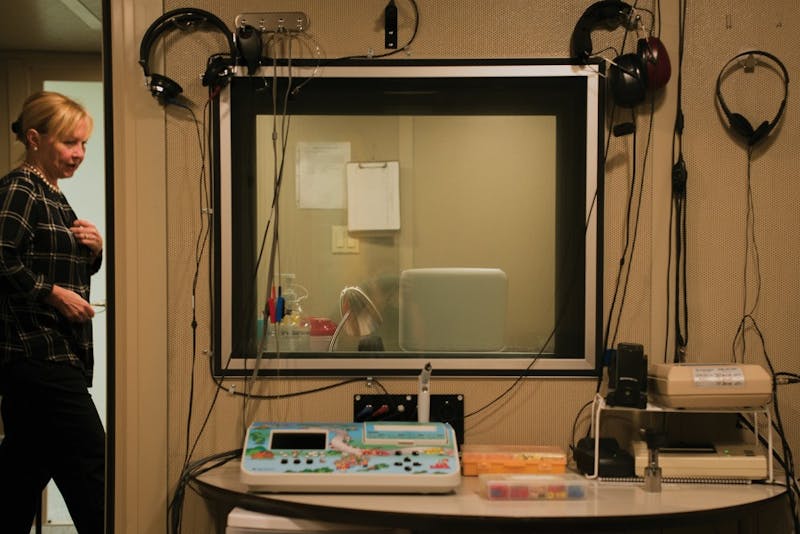
CHANCE BRINKMAN-SULL


CHANCE BRINKMAN-SULL
It was grocery day for Joel Starner. He stood in line at the Kroger deli counter and rattled off his first request — two pounds of Black Forest ham. He wanted to order sliced Cajun chicken, but he suddenly could not voice it.
The man helping him started listing meats and cheeses.
“Turkey? Ham?” he said.
Starner said nothing.
“Chicken? Cheese?”
Still nothing.
Starner was not drawing a blank. He knew exactly what he wanted, but he was blocking.
Blocking, a type of fluency disorder or “disfluency,” comes and goes when it wants with Starner’s speech and gives no clue as to when it will return. The long pauses have no consideration for the friends and strangers with whom Starner interacts.
blocking
/ blok-ing / noun 1. A struggling attempt to say a word when there is no sound. I ----- want.
Some days, Starner said he is “amazingly disfluent.” The more he thinks about trying to speak, the worse it becomes, especially when others try to finish his sentences.
The man behind the deli counter kept probing in what seemed to be an attempt to help Starner jog his memory, but the man’s “helpfulness” started to frustrate Starner. “I told him just to chill out for a second, but I think the tone in my voice made him realize he had screwed up,” he said.
Starner’s family started to notice problems with his speech when he was in second grade. Starner, a junior studying communication sciences and disorders at Ohio University, went to therapy for a few years during grade school before he stopped in the fifth grade. In his case, he said the therapy did not warrant a better result.
The kind of stutter he has, when no words come out at all, is less common. Other disfluencies occur with people who repeat part of a word, sound or syllable.
John McCarthy, a communication sciences and disorders professor and a practicing speech-language pathologist, said it is common for children to mispronounce words and have disfluencies when learning a language. If they are not growing out of it, he said, then parents should analyze if there is a problem.
repitition
/ rep-i-tish-uh-n / noun 1. Repeating of a syllable, sound, word, or phrase. I am a ju-ju-ju-junior.
Someone has a stutter if their speech is disfluent at least 10 percent of the time. A speech-language pathologist diagnoses and assesses treatment, which often leads to speech therapy.
Working with children is common for speech-language pathologists, but they also often work with older individuals who have trouble with language, swallowing or speech after a stroke or head injury.
More than 3 million people in the United States and about 1 percent of the global population have a stutter, according to The Stuttering Foundation. There is no known cause for stuttering, but discoveries link the disfluency to neurological and occasionally genetic causes.
McCarthy added that disfluencies in speech are not just extreme cases. The use of “um” or “like” in between words is a common disfluency.
“Everybody has problems with their speech,” he said. “Everybody has certain situations that make those problems with their speech even more pronounced.”
EMMA HOWELS
The one-and-a-half-year graduate program for speech-language pathology and audiology in the School of Rehabilitation and Communication Studies at OU allows students to practice their skills both in the classroom and with real clients.
prolongation
/ proh-lawng-gey-shun / noun 1. holding onto a sound for an extended period of time. I have to sssstudy.
Clients travel sometimes as far as 45 minutes to their therapy appointments on OU’s campus. The rooms for the Hearing, Speech and Language Clinic located in Grover Center have enough space to fit a few chairs and perhaps one table. TWhe room expands beyond its four walls, however. An observation room is connected by a two-way mirror that hangs on the wall for family to listen in and watch from the other side.
“It can get really wild around here,” Kristi Kinnard, clinical supervisor of speech-language pathology, said. “Patients have an appointment, but sometimes people just show up whenever.”
The clinic is open even when the university is not in session. The methods for helping different age groups vary, Kinnard said.
Many children in therapy, for instance, also have behavioral problems or an autism spectrum disorder, which can be a challenge for the graduate students.
“If you have a client with behavioral issues, meltdowns, hitting, biting, spitting — you can’t really work on speech and language,” Kinnard said. “You’ve got to work on the behavior and speech at the same time.”

EMMA HOWELLS
Kristi Kinnard, a Speech-Language Pathology Supervisor at the Hearing, Speech and Language Clinic, displays the sound treated booth, currently set up to accomodate child clients.
Ally Valeda-Maiden, a junior studying specialized studies in interpersonal relations, remembers having a stutter as early as her first words. Growing up, she spent 10 years in speech therapy.
“I really liked to play outside, so I viewed (therapy) as something as I always tried to get out of,” she said. “I got really good at not stuttering just in therapy.”
Kinnard said stuttering can disappear in therapy, but it does not mean it is gone for good. It is important for those in speech therapy to take what is learned in therapy and apply it to everyday situations, she said.
For example, Valeda-Maiden still has trouble when she feels nervous or when she is unsure of what to say.
“It’s like sounds get stuck in my throat,” she said.
Adults in speech therapy will continue the effort outside of the therapy room by bringing home exercises, Kinnard said. Most times with adults, it is learning to improve upon a stutter and using techniques to try to self-correct.
“If you want to improve communication, you’ve got to remember to use those (techniques),” she said. “Once they have them in their head, I can’t follow them around all day.”
A common misconception is people stutter because they are nervous.
“People stutter, and they have negative experiences, which might make them feel uneasy about it,” McCarthy said.
Interacting with someone who is caught in a block or repetition can be painful to watch, Kinnard said, especially if there are secondary reactions such as eye blinks or an increase in their volume.
“The last thing you want to do is be present for their misery,” she said. “It’s best to listen patiently, though it may be difficult.”
silent pauses
/ sahy-luh-nt pawz-ez / noun 1. Silence in between words or within words. I’ve (pause) known him for years.
When Starner has blocks in public, he said people sometimes ask him if he is nervous or if there is something wrong.
“They can see I’m trying,” he said, but he often notices the other person would rather finish the conversation without him and move on.
Valeda-Maiden said she also has conversations with people who try to finish her sentences, and she finds it annoying.
“Most moments of stuttering rarely lasts longer than five seconds,” McCarthy said. “Just wait for someone who stutters to just finish whatever they’re saying.”
Starner said he has met others who have a stutter that consider it a part of them. He, however, does not see it that way.
“I’d rather not have it, to be honest,” he said.
By becoming a speech-language pathologist, he intends to help others who are trying to find a solution.
“If I can’t fix me, I’ll fix someone else,” he said.
Pronunciations provided Dictionary.com